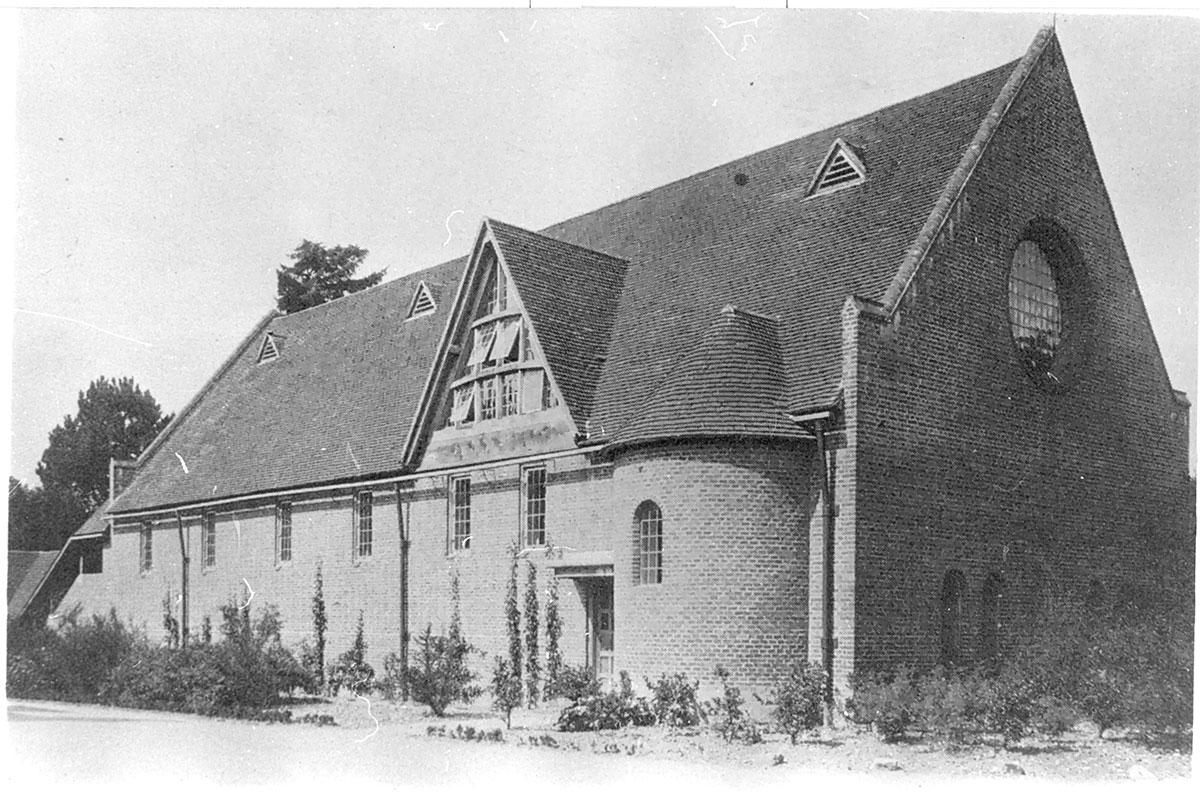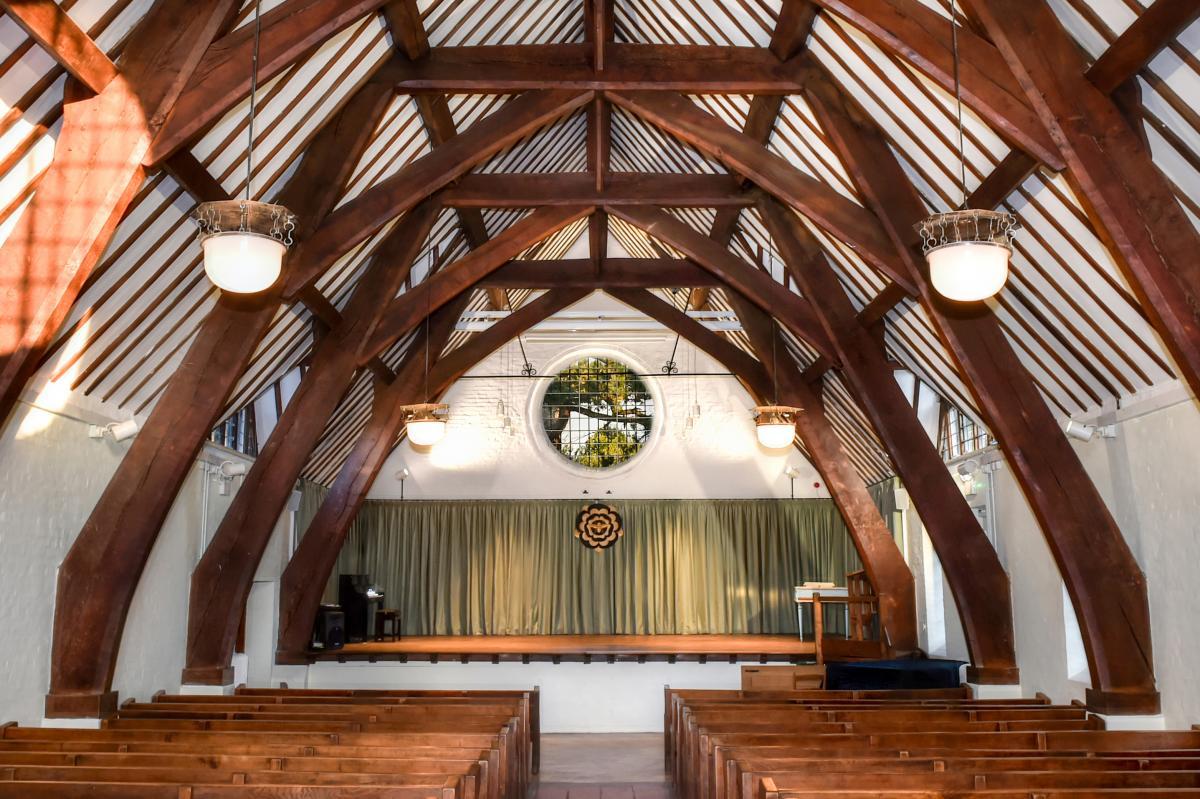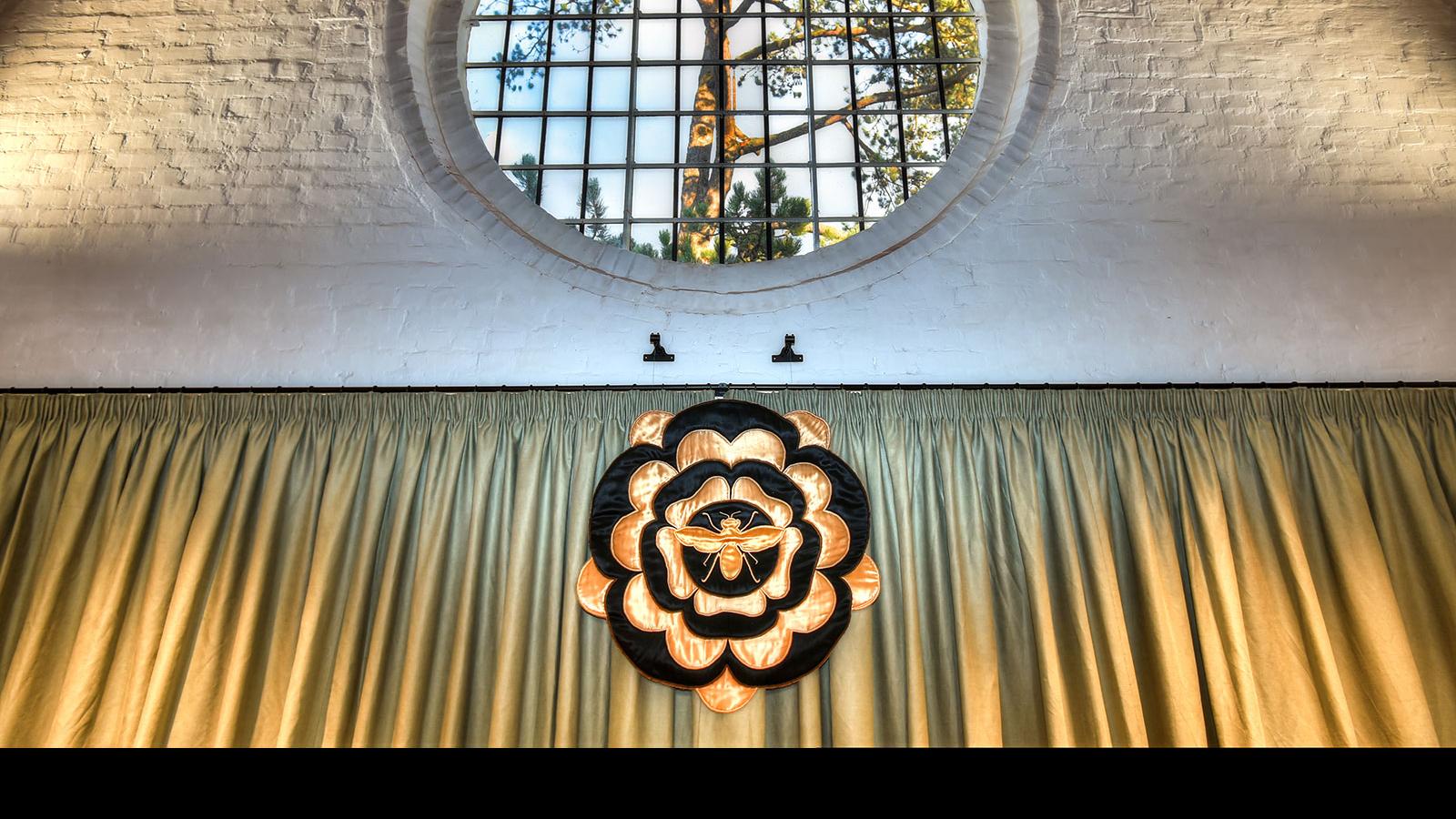By Anna Keay, Old Bedalian (1987-92) and Bedales Governor
Many Bedalians returning to the school over the last few decades will have found it an unsettling experience. On the one hand it is familiar, the blue sign on Church Road, the barnyard, the brick path winding to Steephurst, the smell of the wood in the cricket pavilion. But in other ways it is quite different: new teaching buildings in place of the old encampment of prefab classrooms, unlovely retractable seating in the Quad, and the mysterious fish in the ditch on the back drive seems to have gone (was it ever really there?). But no change has been more baffling to the OB than the disappearance of the Lupton Hall.
For almost a century this magnificent structure was the centre of Bedales. Morning notices, Sunday Jaws, assemblies, handshaking, patchy plays, lovely concerts, hilarious sketch nights, all took place under its soaring cruck frame, the numbers of people skulking in the Sand Quarry measurable exactly by the inches of bench seating left empty every evening. The days and weeks were punctuated by loitering in the Covered Way, trooping in and squeezing up. But ask any of the kids at school in recent times about the building and you would be surprised by the response, ‘never heard of it’, ‘I don’t think I’ve ever been in there’, ‘is it part of the Library?’. When in the mid-1990s the school got too big to fit in, whole-school gatherings moved to the Quad, while the building of the Olivier theatre around the same time created a new venue for drama. As a result the noble old Lupton Hall was abandoned, and so it has remained, untouched and almost unused for very nearly 30 years. I visited a few years ago when helping the school select an architect for a new art and design building, and was shocked to see the old place greying and sad. A plan began to form to bring this spectacular building back to life, a plan which this year has finally come to fruition.

The Lupton Hall was the brainchild of Geoffrey Lupton (1893-1901). After trying, and then abandoning, the family engineering firm, Lupton became a student of the brilliant Arts and Crafts architect and furniture maker, Ernest Gimson. Inspired by this experience, at the age of just 24, Lupton provided the funds for Gimson to create a series of remarkable buildings for Bedales on its new Hampshire site. It would be by far Gimson’s most important architectural commission. The scheme which Gimson drew up was for a brick quadrangle, like an Oxford college, with the Library and Lupton Hall forming the east range. First to be built was the Hall, designed for music, theatre and assemblies, in 1911. Gimson died in 1919 and though the other three sides of the Quadrangle were never built, the Covered Way and Library were finished, with the Library as a memorial to Bedalians killed in the First World War.
The hall that Geoffrey Lupton himself helped raise was a profoundly Bedalian stucture, and an antidote to the grandiose assembly halls of traditional public schools. Expressing John Badley’s egalitarian ideas about education and his belief in the importance of making as well as thinking, the Lupton Hall echoed the great agricultural barns of the Middle Ages which Gimson adored for their simplicity, splendour and craftsmanship. A monumental cruck frame of English oak forms the skeleton of the building, while the walls and roof are of hand-made local brick and tile. Gimson designed not just the shell but the fixtures: benches, light fittings and speaker’s lectern, creating at Bedales arguably the finest Arts and Crafts assemblage in the whole country. In 1954 the Library and Lupton Hall were listed Grade I, putting them in the top 2.5% of all listed buildings in England, particularly remarkable given they were then little more than a generation old.
Over the decades that followed the Lupton Hall was changed to suit the times in ways that eroded the perfection of Gimson’s design. The Covered Way originally extended across the end of the Hall, leading to the Library, but in 1967 a large rectangular opening was knocked through and this section was incorporated into the Lupton Hall to increase the space. Also in the mid-twentieth century heavy green curtains (crowned by the bee) were hung permanently to cloak the stage for theatrical performances and the great round window at the back of the stage was blacked out, giving it the appearance that most of us remember.
In 1954 the Library and Lupton Hall were listed Grade I, putting them in the top 2.5% of all listed buildings in England, particularly remarkable given they were then little more than a generation old
Since the Lupton Hall fell out of regular use in the mid-1990s there have been various attempts to revive it, but without success. With its steeply sloping stage and floor, the building is not a flexible one. There was a proposal a decade or so ago to convert it into a ‘contemporary library suite’ which was to include the insertion of a mezzanine floor across part of the hall. Some thought this was the answer. Personally I was appalled, and had a heated discussion about it with Dennis Archer (Bedales staff, 1974-2008) during a chance meeting at Guildford Station. There was no question that a solution was needed, but it was not this. Luckily that plan was shelved.
The new scheme which we devised a year or so ago had a different starting point. We were not going to try to turn the Lupton Hall into something it could never easily be – an IT room or science lab – but to use it again for one of the main functions for which it had been designed, musical performance. This would give the school’s brilliant music department, still operating from the warren of tiny rooms in the Music School, a magnificent concert hall and would not necessitate damaging or contentious major changes to the building.
To work out how best to repair and modify the Lupton Hall we approached Richard Griffiths, one of the country’s leading conservation architects and a great admirer of Bedales’s Arts and Crafts buildings. Working with Richard and his colleague Kathryn Harris, and contractors R W Armstrong, we decided that we should try and do three things: first, address a series of serious maintenance and conservation issues which were long overdue. Second, to remove from the hall the later changes which were no longer functionally necessary, and which would enable us to restore the building to something like its original splendour. And finally, we wanted to make the spaces (including in the green rooms below and the 1950s brick extension to the west) as usable as possible by Bedalians.

After close study of the drawings and photographs of the Lupton Hall in its first decades, we put together our plans which were executed over the summer of 2017. As the school now has a purpose-built theatre, the stage curtains in the Lupton Hall are no longer needed, and so these have been taken out enabling the large east window to be revealed and repaired and to become, as Gimson intended, the focus of the building. The steep slope on the stage, which made concerts and talks really challenging, has been removed by carefully dropping the back of the stage on its original joists to sit almost level with the front. At the rear, west, end we could not reinstate the Covered Way without making dramatic and very expensive alterations, so instead we inserted brick arches into the stark rectangular opening knocked through in the 1960s, allowing the main volume and what was the Covered Way to be read as distinct entities once again, and creating a foyer area in which a level floor has been reinstated. The rotten and ugly windows onto the Orchard, inserted in what had been unglazed openings, have been removed and instead new leaded windows, following the language of the Library and the rest of the Lupton Hall have been made and installed.
Under the stage the green rooms were repaired and refitted as music practice rooms, and the 1950s extension converted into a seminar room. Along the way major repairs were undertaken to the windows and others original features, the building services were reorganised, the oak frame cleaned and the interior painted and given additional lighting. The scaffolding pole which had long served as the handrail in the Covered Way (how did it come to that?) has gone and a handsome iron replacement has taken its place. Meanwhile in the Library repairs were undertaken and discrete wiring has brought power sockets to the bays to allow laptops to be plugged in there for the first time.
The reactions to the revitalised Lupton Hall have been wonderful, not least from the students who have been performing and the audiences who have come to hear them. For those who never realised it was there, the Lupton Hall has been a revelation. To those of us who knew it well, it feels like justice has at last been done to this hallowed hall. A few finishing touches remain to follow, one of which will be the relocation here of Stanley Spencer’s painting of the interior of the Lupton Hall; its subject, as old hands will remember, A Music Lesson At Bedales.
Further reading
Read Old Bedalian Jane Kirby (1974-79, staff, 2008-19)'s article about the history of the Lupton Hall here.
